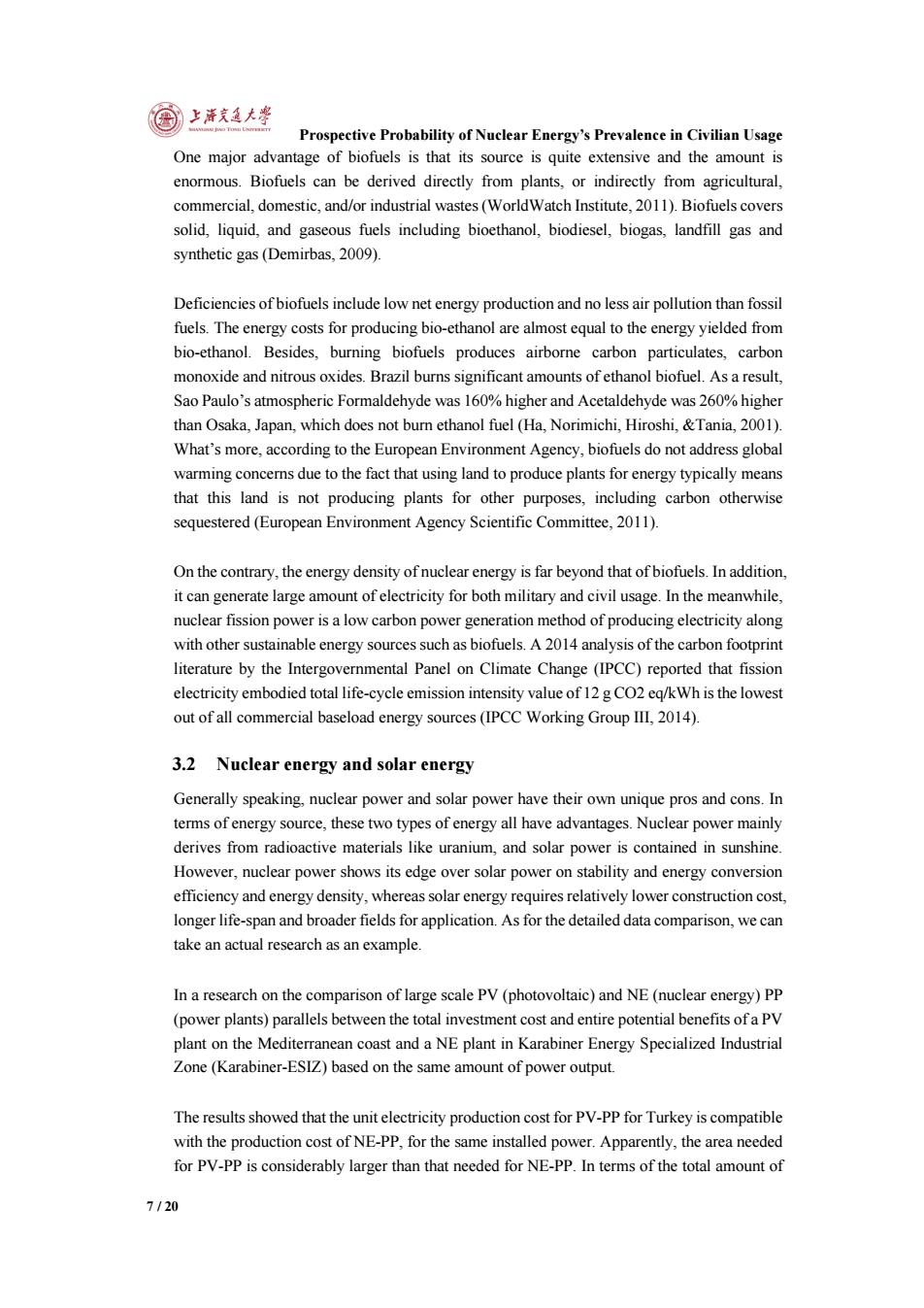正在加载图片...

Prospective Probability of Nuclear Energy's Prevalence in Civilian Usage One major advantage of biofuels is that its source is quite extensive and the amount is enormous.Biofuels can be derived directly from plants,or indirectly from agricultural, commercial,domestic,and/or industrial wastes(WorldWatch Institute,2011).Biofuels covers solid,liquid,and gaseous fuels including bioethanol,biodiesel,biogas,landfill gas and synthetic gas(Demirbas,2009). Deficiencies of biofuels include low net energy production and no less air pollution than fossil fuels.The energy costs for producing bio-ethanol are almost equal to the energy yielded from bio-ethanol.Besides,burning biofuels produces airborne carbon particulates,carbon monoxide and nitrous oxides.Brazil burns significant amounts of ethanol biofuel.As a result. Sao Paulo's atmospheric Formaldehyde was 160%higher and Acetaldehyde was 260%higher than Osaka,Japan,which does not burn ethanol fuel (Ha,Norimichi,Hiroshi,&Tania,2001). What's more,according to the European Environment Agency,biofuels do not address global warming concerns due to the fact that using land to produce plants for energy typically means that this land is not producing plants for other purposes,including carbon otherwise sequestered(European Environment Agency Scientific Committee,2011). On the contrary,the energy density of nuclear energy is far beyond that of biofuels.In addition, it can generate large amount of electricity for both military and civil usage.In the meanwhile, nuclear fission power is a low carbon power generation method of producing electricity along with other sustainable energy sources such as biofuels.A 2014 analysis of the carbon footprint literature by the Intergovernmental Panel on Climate Change (IPCC)reported that fission electricity embodied total life-cycle emission intensity value of 12 g CO2 eq/kWh is the lowest out of all commercial baseload energy sources (IPCC Working Group III,2014). 3.2 Nuclear energy and solar energy Generally speaking,nuclear power and solar power have their own unique pros and cons.In terms of energy source,these two types of energy all have advantages.Nuclear power mainly derives from radioactive materials like uranium,and solar power is contained in sunshine. However,nuclear power shows its edge over solar power on stability and energy conversion efficiency and energy density,whereas solar energy requires relatively lower construction cost, longer life-span and broader fields for application.As for the detailed data comparison,we can take an actual research as an example. In a research on the comparison of large scale PV(photovoltaic)and NE(nuclear energy)PP (power plants)parallels between the total investment cost and entire potential benefits ofa PV plant on the Mediterranean coast and a NE plant in Karabiner Energy Specialized Industrial Zone (Karabiner-ESIZ)based on the same amount of power output. The results showed that the unit electricity production cost for PV-PP for Turkey is compatible with the production cost of NE-PP,for the same installed power.Apparently,the area needed for PV-PP is considerably larger than that needed for NE-PP.In terms of the total amount of 7/20Prospective Probability of Nuclear Energy’s Prevalence in Civilian Usage 7 / 20 One major advantage of biofuels is that its source is quite extensive and the amount is enormous. Biofuels can be derived directly from plants, or indirectly from agricultural, commercial, domestic, and/or industrial wastes (WorldWatch Institute, 2011). Biofuels covers solid, liquid, and gaseous fuels including bioethanol, biodiesel, biogas, landfill gas and synthetic gas (Demirbas, 2009). Deficiencies of biofuels include low net energy production and no less air pollution than fossil fuels. The energy costs for producing bio-ethanol are almost equal to the energy yielded from bio-ethanol. Besides, burning biofuels produces airborne carbon particulates, carbon monoxide and nitrous oxides. Brazil burns significant amounts of ethanol biofuel. As a result, Sao Paulo’s atmospheric Formaldehyde was 160% higher and Acetaldehyde was 260% higher than Osaka, Japan, which does not burn ethanol fuel (Ha, Norimichi, Hiroshi, &Tania, 2001). What’s more, according to the European Environment Agency, biofuels do not address global warming concerns due to the fact that using land to produce plants for energy typically means that this land is not producing plants for other purposes, including carbon otherwise sequestered (European Environment Agency Scientific Committee, 2011). On the contrary, the energy density of nuclear energy is far beyond that of biofuels. In addition, it can generate large amount of electricity for both military and civil usage. In the meanwhile, nuclear fission power is a low carbon power generation method of producing electricity along with other sustainable energy sources such as biofuels. A 2014 analysis of the carbon footprint literature by the Intergovernmental Panel on Climate Change (IPCC) reported that fission electricity embodied total life-cycle emission intensity value of 12 g CO2 eq/kWh is the lowest out of all commercial baseload energy sources (IPCC Working Group III, 2014). 3.2 Nuclear energy and solar energy Generally speaking, nuclear power and solar power have their own unique pros and cons. In terms of energy source, these two types of energy all have advantages. Nuclear power mainly derives from radioactive materials like uranium, and solar power is contained in sunshine. However, nuclear power shows its edge over solar power on stability and energy conversion efficiency and energy density, whereas solar energy requires relatively lower construction cost, longer life-span and broader fields for application. As for the detailed data comparison, we can take an actual research as an example. In a research on the comparison of large scale PV (photovoltaic) and NE (nuclear energy) PP (power plants) parallels between the total investment cost and entire potential benefits of a PV plant on the Mediterranean coast and a NE plant in Karabiner Energy Specialized Industrial Zone (Karabiner-ESIZ) based on the same amount of power output. The results showed that the unit electricity production cost for PV-PP for Turkey is compatible with the production cost of NE-PP, for the same installed power. Apparently, the area needed for PV-PP is considerably larger than that needed for NE-PP. In terms of the total amount of